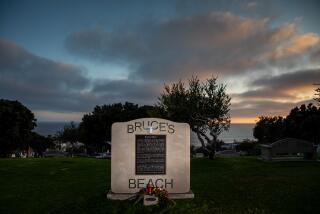Legal Big Guns to Duel in Jail Land Case Appeal
In a case where both sides are seeking a reversal and one a fortune, developer Roque de la Fuente and the County of San Diego have filed appeal briefs in a $55.6-million lawsuit, triggering legal review of a huge jury verdict that has added to the county’s fiscal woes.
The county filed a legal brief last week asking a state appeals court in San Diego to overturn a jury verdict awarding De la Fuente $55.6 million for land it legally seized five years ago to build a jail. De la Fuente countered that all the cash is rightfully his, and said there was no basis for a judge to slash the award to $22.9 million.
The 4th District Court of Appeal in San Diego has not yet set a hearing on the case.
The roster of attorneys listed on the legal briefs signaled just how much is at stake. Between them, the two sides have retained a former state Supreme Court justice and two of California’s leading lawyers in the arcane field of eminent domain.
The case could set statewide precedent in the way private property is valued when government seizes it, lawyers said Monday. It holds broad implications for counties out to build new jails or schools as well as for private property owners seeking a fair shake from financially strapped public agencies.
In addition, the bottom line is that $55.6 million is at issue, lawyers said. “It’s a very, very important case,” said Don Lincoln, a San Diego attorney and one of the county’s lawyers.
De la Fuente did not return a phone call Monday to his office. His attorneys declined to comment.
The case began in 1987, when the county took 525 acres from De la Fuente to build a jail. The site is near the U.S.-Mexico border, about 7 miles east of Interstate 805.
The first phase of the jail, called East Mesa, was recently completed. But the financially beleaguered county, suffering from a $30-million deficit this fiscal year, is so short of cash that it can not afford to staff the maximum security section of the jail. The building sits unused.
Any governmental body may legally seize land under the eminent domain powers of the U.S. Constitution. But it must fairly compensate the owner of the property for the “best use” of the land.
In September, 1990, the jury fixed the land’s value at $55.6 million, saying it was ideally suited for a jail. At the trial, the county contended the land’s best purpose was for houses.
On Dec. 28, 1990, San Diego Superior Court Judge Jeffrey T. Miller offered a new trial or $22.9 million. He based that figure on a review of several commercial and industrial appraisers who testified at the trial.
De la Fuente opted to fight for all $55.6 million.
On Nov. 20, his legal team weighed in with a brief filed at the 4th District Court of Appeal. The briefs list former state Supreme Court Justice Otto Kaus and Los Angeles lawyer Gideon Kanner, one of the state’s leading experts in land use.
The county filed its briefs last Wednesday. It recruited Norman Matteoni, a San Jose attorney who literally wrote the book--a lawyer’s guide--on condemnation cases.
Both sets of legal papers focus on one basic point. A few months after the $55.6 million jury verdict, Miller, who presided over the trial, slashed that sum to $22.9 million. Miller said $55.6 million was “excessive.”
De la Fuente’s lawyers contended simply that Miller had no sound reason to disregard the jury’s $55.6-million award and called the cut to $22.9 million “fundamentally unfair.”
The county responded that the $55.6- million award was based on improper speculation, since it depended on De la Fuente’s plans to build a private jail on the site, which never happened.
In addition, the county claimed, the jury had been improperly “inflamed” into believing that the county had wrongly condemned and taken the land.
More to Read
Sign up for Essential California
The most important California stories and recommendations in your inbox every morning.
You may occasionally receive promotional content from the Los Angeles Times.










